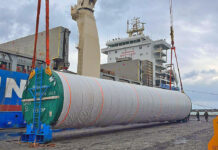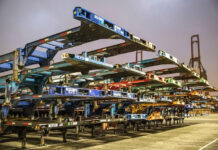
With the shortage of container vessels hitting critical levels, some operators have begun using bulk carriers or other vessel types to move containers.
Alphaliner reported this week that Greek bulk carrier owner Starbulk carried around 1,400TEU of containers on one of its 175,000 dwt Capesize bulkers. The cargo included 200 laden boxes and 1,200 empties repositioned from Europe to China.
Container shipping specialists contacted by Container News said that as bulk carriers are not built to hold containers, extra costs will be involved in arranging lashings to secure the containers in the cargo holds.
Alphaliner noted that recently, various major shippers have in the past months tapped turned to multi-purpose ships and open-hatch cargo ships to ship their boxes overseas.
In July, COSCO Shipping Honor, an open-hatch cargo ship operated by the COSCO group’s project and breakbulk cargo arm, COSCO Shipping Specialized Carriers, was mobilized to carry containers from China to Brazil. Workers in Ningbo port placed lashings to ensure the containers stayed in place on the vessel.
Marine insurers have, however, warned that such actions could jeopardise claims should there be accidents, even as they noted growing interest from bulker operators to carry containers.
West of England P&I Club’s underwriting director Simon Parrott wrote to members stating that the club had seen incidents of bulk carriers being chartered to ship containers. He warned that the carriage of containers on bulk carriers could lead to a number of issues which needed to be addressed for the shipment to be delivered successfully.
Parrott noted that moving containers on bulk carriers could be deemed a change of use. To prevent the risk of cover being prejudiced, members would be advised to contact the underwriting department.
Moreover, North of England P&I Club said in an advisory, dated 17 August, that while it is not opposed to carrying containers on bulk carriers, such voyages involve a lot of careful planning, collaboration and contractual scrutiny.
The North said, “Owners should first liaise with underwriters, and the vessel’s classification society (‘Class’) and Flag State to seek their guidance and advice as to what modifications, if any, would be required to comply with their requirements.
“It’s unusual for a bulk carrier to be fitted out with suitable fittings, equipment and lashings to fulfil this obligation without modification and strengthening of cargo securing arrangements. Additional equipment may be required as well as a need to perform additional strength and stability assessments. Crew capabilities should be also assessed.”
In addition, the vessel’s documentation may need updating to reflect these changes, according to the British insurer.
Martina Li
Asia Correspondent





